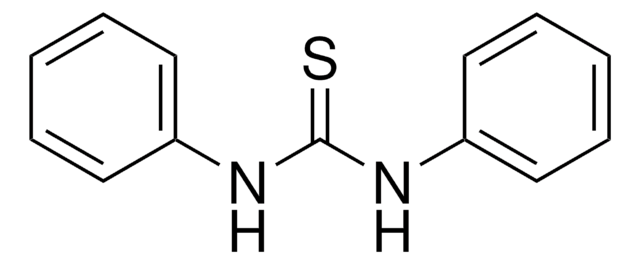96459
Zinc acetate dihydrate
puriss. p.a., ACS reagent, ≥99.0% (KT)
About This Item
Prodotti consigliati
Grado
ACS reagent
puriss. p.a.
Saggio
≥99.0% (KT)
Forma fisica
crystals
Impiego in reazioni chimiche
reagent type: catalyst
core: zinc
Impurezze
≤0.002% total nitrogen (N)
pH
6-7
Anioni in tracce
chloride (Cl-): ≤5 mg/kg
sulfate (SO42-): ≤50 mg/kg
Cationi in tracce
As: ≤0.1 mg/kg
Ca: ≤10 mg/kg
Cd: ≤5 mg/kg
Co: ≤5 mg/kg
Cr: ≤5 mg/kg
Cu: ≤5 mg/kg
Fe: ≤5 mg/kg
K: ≤50 mg/kg
Mg: ≤5 mg/kg
Mn: ≤5 mg/kg
Na: ≤50 mg/kg
Ni: ≤5 mg/kg
Pb: ≤5 mg/kg
Stringa SMILE
O.O.CC(=O)O[Zn]OC(C)=O
InChI
1S/2C2H4O2.2H2O.Zn/c2*1-2(3)4;;;/h2*1H3,(H,3,4);2*1H2;/q;;;;+2/p-2
BEAZKUGSCHFXIQ-UHFFFAOYSA-L
Cerchi prodotti simili? Visita Guida al confronto tra prodotti
Applicazioni
Avvertenze
Danger
Indicazioni di pericolo
Consigli di prudenza
Classi di pericolo
Acute Tox. 4 Oral - Aquatic Chronic 2 - Eye Dam. 1
Codice della classe di stoccaggio
11 - Combustible Solids
Classe di pericolosità dell'acqua (WGK)
WGK 3
Punto d’infiammabilità (°F)
Not applicable
Punto d’infiammabilità (°C)
Not applicable
Certificati d'analisi (COA)
Cerca il Certificati d'analisi (COA) digitando il numero di lotto/batch corrispondente. I numeri di lotto o di batch sono stampati sull'etichetta dei prodotti dopo la parola ‘Lotto’ o ‘Batch’.
Possiedi già questo prodotto?
I documenti relativi ai prodotti acquistati recentemente sono disponibili nell’Archivio dei documenti.
I clienti hanno visto anche
Il team dei nostri ricercatori vanta grande esperienza in tutte le aree della ricerca quali Life Science, scienza dei materiali, sintesi chimica, cromatografia, discipline analitiche, ecc..
Contatta l'Assistenza Tecnica.












